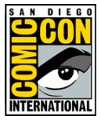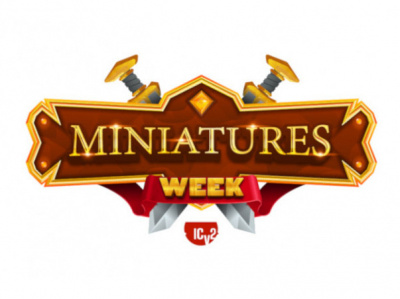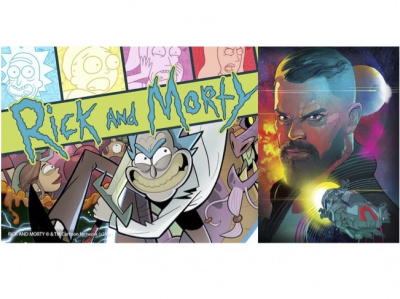
We caught up with Comic-Con International Director of Marketing and Public Relations David Glanzer as Comic-Con wrapped up on Sunday to talk about this year’s show and plans for the 2013 WonderCon.
Can you tell us about the tragedy that happened before the show opened this year (see "'Twilight' Fan Killed at Comic-Con")?
We’re referring everything over to the SDPD because we haven’t been briefed yet.
We’ve noticed over the last few years that you have done a tremendous number of things to move activities out of the Convention Center and reduce congestion--like moving the fulfillment center where you get freebies after a panel over to the Marriott. Has that enabled you to increase the number of people who can attend the Con?
Yes. The year before last we had about 126,000; last year we had about 130,000. I have a feeling we’re going to be in between those this year. We really won’t know until the end of the show. We’re very conservative with our numbers. It’s not just how many badges you sold but who redeemed them. Once we figure all that out, we’ll know where we’re at, but I think we’ll always be somewhere around that amount.
Moving the fulfillment room off-site allows us to use that room for programming, and I think you’ve seen a lot of stuff outside too, in public parks, with a lot of people with badges on. It looks like people have been able to circulate outside and back in, upstairs and downstairs, which makes hopefully, less congestion.
Between two years ago and last year you were able to up the numbers a little bit, but between last year and this year you don’t think there will be much of an increase?
I don’t think it will ever be much more than what we have now. We’ll see what happens in the future, but right now we’re at a comfortable number.
One of the memes out there is that the show is less about comics, but we’ve observed that you seem to have about the same square feet for comic dealers as you’ve had for years. Is that the case?
Yes, it is. I think this started back when someone said they saw less white box dealers at the show. I don’t actually know if we have less white box dealers than we have in recent years, but we have less white box dealers than we had 20 years ago. I think there are less white box dealers than there were 20 years ago, so I think it’s hard to say, "Why don’t have more than currently exist?" And clearly we can’t do that.
Comic-Con has always been about comics, films and fantasy literature, and look at our guest list. It’s still an impressive list of comics professionals. We have every major comics publisher on the floor, a lot of independent comics, and lot of comics creators in Artist’s Alley, and a tremendous amount of comics programming. I would put all of that up against any other convention anywhere in the United States and maybe even the world.
That raises a question. We’ve seen this show referred to as the biggest show of its type in the world. It’s unclear how they count the numbers at Comiket in Japan, but do you think that’s true?
I do. The Japan show is mostly a 'zine show. I think it has 300,000 people, but it’s a very different show than San Diego. We have comics publishers, toy manufacturers, and movie studios. My understanding is they don’t have that.
It’s a doujinshi show.
Exactly. I think the same thing is true with Angouleme, which as I understand it, is partially or totally funded by the government--and it lasts a month or something like that. Not to take anything away from Angouleme, but we’ve had people who’ve been to both shows and who really enjoy our show because of the diversity of what we have not only in terms of programming, but in terms of what’s on the floor. My understanding is they don’t have one central location that has comics, games toys and movies and things like that.
It terms of a comic book and popular arts convention, I think Comic-Con is probably the biggest in the world.
One of the things you did differently this year was how you handled advance registration for professionals and press. The perception is that you’re getting a little tighter on that and it was a little harder to get those kinds of passes. Was that the case and did that allow you to sell more tickets?
One of the things we’re trying to do is crack down on counterfeits. The building can accommodate X amount of people. We make it a very good faith effort, and I think we’ve been very successful, in matching that number or maybe coming in a little bit less. The problem arises when there’s someone with a fake badge because there’s no way to count that person. One of the things we instituted that we started last year was the member ID system, which we stuck with this year.
Another thing is to make sure that those who really qualify can get it in. Comic-Con has always been known to be friendly in terms of press and pros. We’re getting so many requests, it’s really important that those people who truly qualify have the opportunity to attend. In terms of press, it was a lot more difficult than it’s been in the past, but it’s not fair to somebody who has worked diligently all year to promote and report on comics and related popular art forms, to come in in favor of someone who maybe makes a big splash, but doesn’t report on this all year round.
There are still growing pains. I know there are certainly growing pains in pros. Hopefully that will all go away when this expansion happens, if it happens.
Is that to make sure that you got the right people in, or were you trying reduce the number of free passes so you could sell more tickets?
We would love to allow more attendees to come, but it’s not going to do the attendees any good if you don’t have really good professionals. It’s the same thing with exhibitors, too. It’s awful that we have a finite amount of space for exhibitors, because you can’t welcome new exhibitors unless someone shrinks their booth or doesn’t come back, so each one of those categories is really important to us. The idea is that, in the past, where someone may have been a secretary, or someone may have been very loosely related to the industry, could get into the show, we’re trying to be a little more critical of that now.
Where are you on prices and where will you be next year?
We don’t know yet, we’ll analyze that after the show. We did away with our discounted rates last year. For a long time it used to be if you bought your [next year’s] badge at the show, you got a tremendous discount, and a few months after that it went up a little bit, and a few months after that it went up a little bit and the most expensive badge was one you purchased on site. Nobody ever got to that point in the last four or five years, so the idea of an incentive to buy early didn’t exist anymore so we got rid of the incentives. And this year we sold out in an hour and a half.
One of the things you will see is signage around the building and that is a way to augment our income without having to drastically raise our prices for exhibitors and attendees. There will probably always be a certain amount of increase in those areas, but hopefully so long as we have the ability to sponsor out some areas, offset some of our hard dollar costs, you’ll see more signage.
Have you made any decisions about WonderCon for next year?
We haven’t. We really want to move back to San Francisco, but again, we can’t get dates up there until six months out typically. WonderCon is typically a spring show. One of the things we’re faced with is how to make this all work. Now we’re in the midst of Comic-Con. Once this is done, we’ll start working on APE more diligently, but WonderCon will be one of the things we’ll be focusing on because the Anaheim show ended up being successful. We heard from a lot of the Anaheim exhibitors that they enjoyed the show and thought it was a nice fit. We never got the final numbers on that, but the numbers looked good. We’d love to be back in San Francisco, but Anaheim may not be a bad thing.
Are you going to do a spring show one way or the other?
I think so, yes.
Can you tell us about the tragedy that happened before the show opened this year (see "'Twilight' Fan Killed at Comic-Con")?
We’re referring everything over to the SDPD because we haven’t been briefed yet.
We’ve noticed over the last few years that you have done a tremendous number of things to move activities out of the Convention Center and reduce congestion--like moving the fulfillment center where you get freebies after a panel over to the Marriott. Has that enabled you to increase the number of people who can attend the Con?
Yes. The year before last we had about 126,000; last year we had about 130,000. I have a feeling we’re going to be in between those this year. We really won’t know until the end of the show. We’re very conservative with our numbers. It’s not just how many badges you sold but who redeemed them. Once we figure all that out, we’ll know where we’re at, but I think we’ll always be somewhere around that amount.
Moving the fulfillment room off-site allows us to use that room for programming, and I think you’ve seen a lot of stuff outside too, in public parks, with a lot of people with badges on. It looks like people have been able to circulate outside and back in, upstairs and downstairs, which makes hopefully, less congestion.
Between two years ago and last year you were able to up the numbers a little bit, but between last year and this year you don’t think there will be much of an increase?
I don’t think it will ever be much more than what we have now. We’ll see what happens in the future, but right now we’re at a comfortable number.
One of the memes out there is that the show is less about comics, but we’ve observed that you seem to have about the same square feet for comic dealers as you’ve had for years. Is that the case?
Yes, it is. I think this started back when someone said they saw less white box dealers at the show. I don’t actually know if we have less white box dealers than we have in recent years, but we have less white box dealers than we had 20 years ago. I think there are less white box dealers than there were 20 years ago, so I think it’s hard to say, "Why don’t have more than currently exist?" And clearly we can’t do that.
Comic-Con has always been about comics, films and fantasy literature, and look at our guest list. It’s still an impressive list of comics professionals. We have every major comics publisher on the floor, a lot of independent comics, and lot of comics creators in Artist’s Alley, and a tremendous amount of comics programming. I would put all of that up against any other convention anywhere in the United States and maybe even the world.
That raises a question. We’ve seen this show referred to as the biggest show of its type in the world. It’s unclear how they count the numbers at Comiket in Japan, but do you think that’s true?
I do. The Japan show is mostly a 'zine show. I think it has 300,000 people, but it’s a very different show than San Diego. We have comics publishers, toy manufacturers, and movie studios. My understanding is they don’t have that.
It’s a doujinshi show.
Exactly. I think the same thing is true with Angouleme, which as I understand it, is partially or totally funded by the government--and it lasts a month or something like that. Not to take anything away from Angouleme, but we’ve had people who’ve been to both shows and who really enjoy our show because of the diversity of what we have not only in terms of programming, but in terms of what’s on the floor. My understanding is they don’t have one central location that has comics, games toys and movies and things like that.
It terms of a comic book and popular arts convention, I think Comic-Con is probably the biggest in the world.
One of the things you did differently this year was how you handled advance registration for professionals and press. The perception is that you’re getting a little tighter on that and it was a little harder to get those kinds of passes. Was that the case and did that allow you to sell more tickets?
One of the things we’re trying to do is crack down on counterfeits. The building can accommodate X amount of people. We make it a very good faith effort, and I think we’ve been very successful, in matching that number or maybe coming in a little bit less. The problem arises when there’s someone with a fake badge because there’s no way to count that person. One of the things we instituted that we started last year was the member ID system, which we stuck with this year.
Another thing is to make sure that those who really qualify can get it in. Comic-Con has always been known to be friendly in terms of press and pros. We’re getting so many requests, it’s really important that those people who truly qualify have the opportunity to attend. In terms of press, it was a lot more difficult than it’s been in the past, but it’s not fair to somebody who has worked diligently all year to promote and report on comics and related popular art forms, to come in in favor of someone who maybe makes a big splash, but doesn’t report on this all year round.
There are still growing pains. I know there are certainly growing pains in pros. Hopefully that will all go away when this expansion happens, if it happens.
Is that to make sure that you got the right people in, or were you trying reduce the number of free passes so you could sell more tickets?
We would love to allow more attendees to come, but it’s not going to do the attendees any good if you don’t have really good professionals. It’s the same thing with exhibitors, too. It’s awful that we have a finite amount of space for exhibitors, because you can’t welcome new exhibitors unless someone shrinks their booth or doesn’t come back, so each one of those categories is really important to us. The idea is that, in the past, where someone may have been a secretary, or someone may have been very loosely related to the industry, could get into the show, we’re trying to be a little more critical of that now.
Where are you on prices and where will you be next year?
We don’t know yet, we’ll analyze that after the show. We did away with our discounted rates last year. For a long time it used to be if you bought your [next year’s] badge at the show, you got a tremendous discount, and a few months after that it went up a little bit, and a few months after that it went up a little bit and the most expensive badge was one you purchased on site. Nobody ever got to that point in the last four or five years, so the idea of an incentive to buy early didn’t exist anymore so we got rid of the incentives. And this year we sold out in an hour and a half.
One of the things you will see is signage around the building and that is a way to augment our income without having to drastically raise our prices for exhibitors and attendees. There will probably always be a certain amount of increase in those areas, but hopefully so long as we have the ability to sponsor out some areas, offset some of our hard dollar costs, you’ll see more signage.
Have you made any decisions about WonderCon for next year?
We haven’t. We really want to move back to San Francisco, but again, we can’t get dates up there until six months out typically. WonderCon is typically a spring show. One of the things we’re faced with is how to make this all work. Now we’re in the midst of Comic-Con. Once this is done, we’ll start working on APE more diligently, but WonderCon will be one of the things we’ll be focusing on because the Anaheim show ended up being successful. We heard from a lot of the Anaheim exhibitors that they enjoyed the show and thought it was a nice fit. We never got the final numbers on that, but the numbers looked good. We’d love to be back in San Francisco, but Anaheim may not be a bad thing.
Are you going to do a spring show one way or the other?
I think so, yes.







